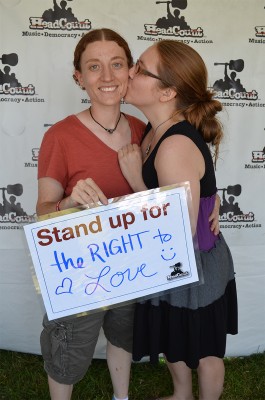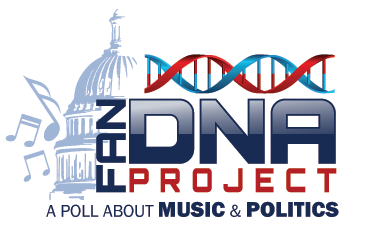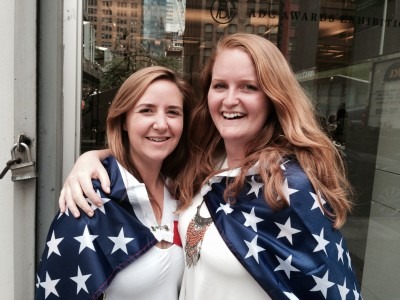The years between elections always leave HeadCount asking, “What else can we do to give our community greater voice?”
In 2011, that led HeadCount to take a closer look at the very people it serves—the live music community. What were their interests? What did they want from our political system? What did they want from the musicians they loved to go see?
In order to get to the bottom of this, HeadCount launched two fascinating campaigns that came to be known as The Fan DNA Project and Signs of the Times. Both sought to examine the beliefs, backgrounds, motivations, interests and desires of the people that attended the shows and festivals that HeadCount was regularly a part of.
2011 also saw the organization hire two all-star staff members that were more than capable of pulling these projects off. The first was Laurie Lenninger, a volunteer Team Leader who left her job in Austin to join HeadCount in New York City. The other was Jane Henderson, an intern who got her start at the beginning of 2011 before being hired full-time later in the year. Anyone that is familiar with HeadCount knows that these two are the heart and soul, the blood and guts that have made the nonprofit’s work possible for the past three years.
“When I first heard HeadCount, I was immediately smitten,” recalls Henderson. “My life had always followed two passions—music and activism—and HeadCount was the perfect cocktail of both. Giving back to my community while seeing some of my favorite bands—it was hard to say no to. Without a doubt the best decision I ever made as a 20 year old.”
“I had been volunteering as a team leader in for about six months before I came on full-time,” adds Lenninger. “I was drawn to the opportunity to take on a leadership role and couldn't say no when Andy [Bernstein] asked me to move to New York. I really enjoyed the opportunity to be creative to reach HeadCount's goals.”
 With two new badasses on the team, HeadCount was able to dive right into their campaigns. The first one, Signs of the Times, saw volunteers ask concert and festivalgoers to express themselves with a message on a sign. Team Leaders would then take a photo of the person, who would be holding their message to the world (for example: “I believe in freedom” or “More money for schools”). The photos were then uploaded to a Facebook photo gallery, where people voted for the sign they liked best, and prizes ranging from free music tickets to artist meet and greets were given to the winners.
With two new badasses on the team, HeadCount was able to dive right into their campaigns. The first one, Signs of the Times, saw volunteers ask concert and festivalgoers to express themselves with a message on a sign. Team Leaders would then take a photo of the person, who would be holding their message to the world (for example: “I believe in freedom” or “More money for schools”). The photos were then uploaded to a Facebook photo gallery, where people voted for the sign they liked best, and prizes ranging from free music tickets to artist meet and greets were given to the winners.
Sign of the Times was the perfect campaign for a non-election year in a few ways. Not only did it give HeadCount a great opportunity to engage the people of the music community and find out what was on their minds, it also provided a boost to HeadCount’s social media operation.
“Signs of the Times was really a game changing campaign for HeadCount,” says Lenninger. We had been looking for the best way to utilize social media and also wanted to get people thinking about issues they cared about to engage them around the political process. Signs of the Times was a beautiful marriage of both. The campaign almost doubled our digital media presence, and it became the inspiration for much of what we've done since. It confirmed the importance of using photography for our digital media campaigns and we've taken bits of Signs of the Times to execute our clipboard campaign, #SoundOff and this year's #GoVote campaign.”
 The Fan DNA project was a bit different than Sign of the Times, but it still had the same goal of developing a greater understanding of the music community, albeit in a less public manner. HeadCount volunteers would ask fans to fill out lengthy surveys instead of registering them to vote. The questions ranged from: “What is your favorite band?” to “Describe the current state of America” to “Have you ever hooked up with someone at a show?”
The Fan DNA project was a bit different than Sign of the Times, but it still had the same goal of developing a greater understanding of the music community, albeit in a less public manner. HeadCount volunteers would ask fans to fill out lengthy surveys instead of registering them to vote. The questions ranged from: “What is your favorite band?” to “Describe the current state of America” to “Have you ever hooked up with someone at a show?”
It may sound kind of silly, but Fan DNA provided some pretty interesting (though not totally scientific) data about the music community. For instance, did you know that there is significant overlap between the Dave Matthews Band, Pearl Jam and Ben Harper fanbases, but not nearly as much overlap between the Dave Matthews Band, Phish and Furthur fanbases? Did you know that, the older a music fan is, the more likely they are to say that the current state of America is “messed up and we better do something?” It was these kinds of tidbits that HeadCount found so illuminating, and which it shared with its audience and its partnered artists when the data was finally published.
 “Fan DNA was interesting because it gave hundreds of festivalgoers across the country a chance to let us know what mattered most to them,” remembers Henderson. “The reasons that they hit the polls, what bothered them most about our political landscape, even what music they enjoyed. I'd like to believe that, with Fan DNA, we created a conversation that would last longer than a weekend of music.”
“Fan DNA was interesting because it gave hundreds of festivalgoers across the country a chance to let us know what mattered most to them,” remembers Henderson. “The reasons that they hit the polls, what bothered them most about our political landscape, even what music they enjoyed. I'd like to believe that, with Fan DNA, we created a conversation that would last longer than a weekend of music.”
HeadCount once again proved what those that have followed the organization had already known for years. As important as voter registration may be, its not the organization's sole purpose. HeadCount exists to keep a finger on the pulse of the music community and, in 2011, it did that with flying colors.
